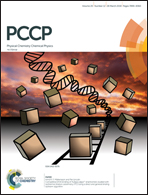The direct observation of electron backflow in an organic heterojunction formed by two n-type materials
Abstract
Many physical processes such as exciton interfacial dissociation, exciton interfacial recombination, and exciton–electron and exciton–hole interactions coexist at the interface of organic solar cells (OSC). In this study, the direction of free charge generation is defined as the direction from the interface to the side where free charges are left. For a p–n type device, the direction of free electron (hole) generation from exciton dissociation at the donor/accepter (D/A) interface is the same as the subsequent transportation direction under the built-in electric field. However, the direction of free electron (hole) generation from exciton–exciton recombination across the D/A interface is opposite to the direction of free charge transportation. Both free charges generated from exciton interfacial dissociation and recombination are contributed to the photocurrent for a p–n type device. In a device with a heterojunction formed by two n-type materials (here it is defined as an n–n type device), the direction of free electron (hole) generation from exciton recombination across the interface is also the same as the subsequent free charge transportation. At the same time, there are also some free electrons (free holes) generated by exciton interfacial dissociation. The direction of free charge generation from exciton dissociation for this n–n type device is also opposite to the direction of free charge transportation. However, only free charges generated from exciton interfacial recombination are contributed to the photocurrent for an n–n type device. But so far there has been no direct experimental evidence to prove the above theories. In this work, an NPB interfacial layer with a high LUMO was introduced in an n–n type OSC to inhibit the backflow of electrons, which are generated from exciton dissociation at the heterojunction formed by two n-type materials, enhancing the device performance accordingly. This work is conducive to interfacial engineering in an OSC to further improve its performance.



 Please wait while we load your content...
Please wait while we load your content...